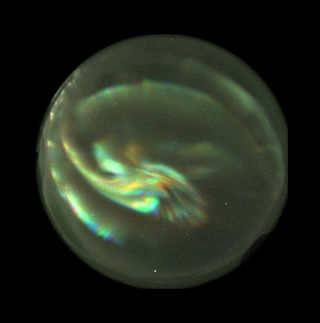Camera Gives New Look at Earth's Amazing Auroras

It's quite a treat to get a look at the shimmering, mysterious northern (or southern) lights. But you've probably never seen them like this.
Norwegian researchers have built a new camera that's provided a more detailed glimpse of dazzling auroras than ever before, as it is capable of rapidly capturing and analyzing multiple wavelengths, or colors, of light at the same time.
Current cameras lack the ability to capture and measure multiple slivers of the visible spectrum. That means if researchers want to study auroras by looking at specific bands of light, they have to use a series of filters to block out the colors they don't want, according to a release from the Optical Society of America, the publisher of the journal Optics Express, where details of the camera were published today (Nov. 30).
The camera, known as the NORUSCA II hyperspectral camera, achieves the same result without any moving parts, using its advanced optics to switch among all of its 41 separate optical bands in a matter of microseconds, many times faster than previously possible, the release noted. [See images of auroras.]

Auroras are created when charged particles from the sun penetrate Earth's magnetic field and react with molecules in the air, lighting up skies in the Northern and Southern hemispheres. These beautiful displays in the night sky reveal important information about the Earth's upper atmosphere and the way our planet responds to powerful solar storms. By allowing researchers to quickly analyze different bands of light in auroras, the camera could pave the way to better understand the phenomenon and what exactly goes on in the atmosphere during solar storms.
On Jan. 24, 2012, when researchers were first testing the camera, they witnessed a major solar flare that released a burst of high-energy particles known as a coronal mass ejection (CME). The CME eventually hit Earth's magnetic field, creating magnificent auroras and a chance to test the new device.
The camera revealed something unexpected in the event: a faint wave pattern of unknown origin in the lower atmosphere. The wave pattern resembles "airglow" — the natural emission of light by Earth's atmosphere. Airglow can be produced by a variety of known sources, including cosmic rays striking the upper atmosphere and chemical reactions. But its appearance at the same time as the aurora suggests that it may also be caused by a previously unrecognized source.
Get the Space.com Newsletter
Breaking space news, the latest updates on rocket launches, skywatching events and more!

"This would be an entirely new phenomenon and if confirmed, would be the first time airglow has been associated with auroras," said Fred Sigernes, a researcher at Norway's University Centre in Svalbard who worked on the camera, in the statement.
Follow OurAmazingPlanet on Twitter @OAPlanet. We're also on Facebook and Google+.
Join our Space Forums to keep talking space on the latest missions, night sky and more! And if you have a news tip, correction or comment, let us know at: community@space.com.
OurAmazingPlanet was founded in 2010 by TechMediaNetwork, which owned Space.com at the time. OurAmazingPlanet was dedicated to celebrating Earth and the mysteries still to be answered in its ecosystems, from the top of the world to the bottom of the sea. The website published stories until 2017, and was incorporated into LiveScience's Earth section.
Most Popular



